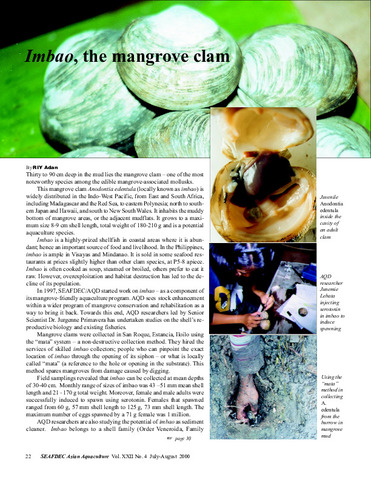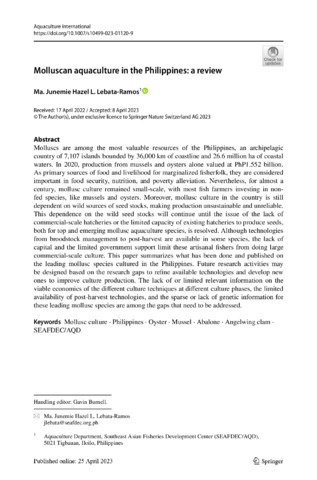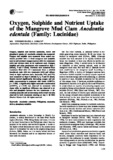| dc.contributor.author | Primavera, Jurgenne | |
| dc.contributor.author | Lebata, M. J. H. L. | |
| dc.contributor.author | Gustilo, Lillian F. | |
| dc.contributor.author | Altamirano, Jon | |
| dc.coverage.spatial | Panay | en |
| dc.coverage.spatial | Guimaras | en |
| dc.date.accessioned | 2013-12-18T06:27:03Z | |
| dc.date.available | 2013-12-18T06:27:03Z | |
| dc.date.issued | 2002 | |
| dc.identifier.citation | Primavera, J. H., Lebata, M. J. H. L., Gustilo, L. F., & Altamirano, J. P. (2002). Collection of the clam Anodontia edentula in mangrove habitats in Panay and Guimaras, central Philippines. Wetlands Ecology and Management, 10(5), 363-370. | en |
| dc.identifier.issn | 0923-4861 | |
| dc.identifier.uri | http://hdl.handle.net/10862/1854 | |
| dc.description.abstract | The mangrove clam Anodontia edentula is highly prized in the Philippines for its flavor and large size. Because this infaunal species is found down to one meter deep in mangrove areas, harvesting the clam reportedly damages mangrove stands. To evaluate such reports, a survey of collection methods was undertaken in Panay and Guimaras, central Philippines in August 1997-December 1999. Host to chemosynthetic bacterial symbionts that utilize sulfide as energy source, A. edentula are strategically situated in sulfide-rich anoxic substrates but also gain access to oxygenated seawater through a ventilation burrow or tube. By locating the opening of this burrow, collectors can detect the presence of a buried clam and harvest it nondestructively with a blade or bare hands. In contrast, the indiscriminate tilling of wide mangrove areas can damage mangrove plants. Most collectors were 40-45 years old with 22-30 years collection experience, married with 5-7 children, and had low educational attainment. They sold clams directly in the local markets or through middlemen (to restaurants and beach resorts); sales provided from 10% to 100% of daily family income. Collectors complained of decreasing clam sizes and numbers and the physically strenuous work of collecting. | en |
| dc.language.iso | en | en |
| dc.publisher | Kluwer Academic Publishers | en |
| dc.subject | Anodontia edentula | en |
| dc.subject | gleaning | en |
| dc.title | Collection of the clam Anodontia edentula in mangrove habitats in Panay and Guimaras, central Philippines | en |
| dc.type | Article | en |
| dc.citation.volume | 10 | |
| dc.citation.issue | 5 | |
| dc.citation.spage | 363 | |
| dc.citation.epage | 370 | |
| dc.citation.journalTitle | Wetlands Ecology and Management | en |
| dc.subject.asfa | burrowing organisms | en |
| dc.subject.asfa | chemosynthesis | en |
| dc.subject.asfa | clam fisheries | en |
| dc.subject.asfa | ecosystem disturbance | en |
| dc.subject.asfa | symbionts | en |
| dc.subject.asfa | environmental management | en |
| dc.subject.asfa | environmental impact | en |
| dc.subject.asfa | harvesting | en |
| dc.subject.asfa | mangrove swamps | en |
| dc.subject.asfa | plant population | en |
| dc.subject.asfa | shellfish | en |
| dc.subject.asfa | sulphides | en |
| dc.subject.asfa | Bacteria | en |
| dc.subject.asfa | food security | en |
| dc.identifier.doi | 10.1023/A:1020983218203 | |
| dc.subject.scientificName | Anodontia edentula | en |
| local.subject | Bacterial symbionts | en |
| local.subject | Food security | en |
| local.subject | Gleaning | en |
| local.subject | Lucinid bivalve | en |
| local.subject | Mangrove clam | en |
| local.subject | imbao | hil |



